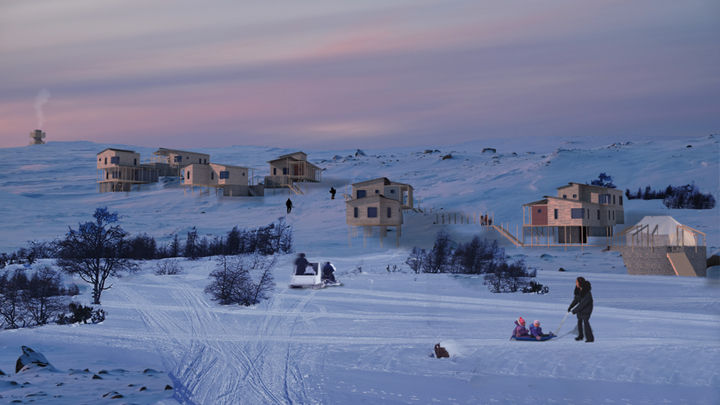

Olivia Ikey
Arctic Change conference (2017)
"We need to work with local entrepreneurs and businesses to create coop opportunities with youth, to create coop apartments, coop housing where youth are set as a board of directors, and we make decisions with our houses and how we will manage them.”
Nunavik villages and their residents have shown great skill and resilience in adapting to imposed situations, particularly housing. In this area, the lack of choices is in stark contrast with the Inuit values of community, inclusive decision making, and cultural safety.
Today’s residents have no choice in selecting a house, its location or its neighbours. The waiting period for housing is long and arduous—especially for the young. Although a program to access homeownership exists in the form of a subsidy, the process remains difficult, with labor contracts and supervision, insurance, payment calendar, and financial risks, not to mention the stress involved.
Nunavimmiut state that the lack of choice in, access to, and control over their homes is an important barrier to fulfilment, autonomy, and empowerment.
What We've Learned
Realities
Paths for Change
Having choices and control over one’s own living environment is a way for Inuit to affirm their values and identity. This not only strengthens attachment to home and community but also instills a lasting sense of pride and belonging.
These choices should include a variety of tenure options and housing types according to a “spectrum” of alternatives to fit with different family and evolving realities. One aspiration is the possibility of living just outside the village; possibly “off-grid” yet close enough to school and village services.
Strategies toward greater autonomy in the area of housing development also echo local ingenuity to find innovating solutions for more space. The sharing or mutualization of amenities (such as storage and equipment) builds on the Inuit values of cooperation and mutual aid to reduce individual footprints on the land.
Calls to Action
42. Offer tenure options
Develop alternatives to private ownership and social housing to better suit a growing number of housing needs: co-ownership (cooperative, co-housing), rentals (private, non-profit), rent-to-own, transitional (temporary stay, shelter, co-living), etc.

43. Offer type options
Build diverse housing types within the same neighbourhood to enable people to live together in detached (single-family, tiny house), joined (duplex, rowhouse), or collective (multifamily, elderly, youth) housing.
Encourage solidarity among generations with intergenerational housing or by maximizing proximity between youth and elders’ residences.

44. Offer location options
Offer the possibility of living outside the village year-round in “off-grid” settlements.
Link these settlements with working opportunities (e.g. live/work communities dedicated to food production) and community transportation.

45. Build shared amenities
Share amenities between willing households (family, friends) to lower individual costs (to invest in better housing), optimize solidarity, and multiply opportunities for social activities/interaction.
Think of innovative options such as “in-between” porches, shared storage or shacks, laundry facilities, community workshops/makerspaces, and greenhouses.

This architectural design project looks at the duality of current social housing in Nunavik and the desire for Inuit autonomy. The absence of local decision making accentuates the “institutional” aspect of Northern housing and widens the gap between housing, culture, and local aspirations.
If Inuit were able to choose the location, form, and management of their housing, they have a better chance of developing an architecture best suited to their reality. This project seeks to demonstrate that increased local decision making can have a positive impact on both governments and the quality of life of Northerners.
This new social housing model supports the desire and value of Kangiqsualujjuammiut autonomy on three levels: territory, spatial organization, and construction. The design encourages choice by offering a catalogue of modules of different sizes, which can be combined depending on family needs. Inspired by the spatial organization of the igloo, the modules use both human and local materials and resources. The project aims at giving residents the chance to participate in the design while developing a community-based construction industry.
By A. Côté, École d’architecture de l’Université Laval, 2022
Housing as a Tool for Inuit Empowerment
Innovations: Thinking Outside the Box
References
Open Access
Côté, A, Ikey, O (2022) Towards the autonomy of Inuit communities in the production of housing in Nunavik: Local engagement and citizen participation. Inuit Studies Conference, June. https://www.youtube.com/watch?v=c8CVESRaz6Q
Grégoire, L (2019) Homeland Security: North and South meet to talk housing in Nunavik. Nunatsiak News. 15th October. https://nunatsiaq.com/stories/article/homeland-security-north-and-south-meet-to-talk-housing-in-nunavik/
Ikey, O (2020) Speaking Out : Housing Issues for Youth in Nunavik, Études Inuit Studies 44 (1-2), pp. 261-267. https://doi.org/10.7202/1081805ar
Ikey, O. (2016). Les problèmes de logement au Nunavik, quelques faits. Mémoire présenté au Comité sénatorial permanent des peuples autochtones, Ottawa. https://sencanada.ca/content/sen/committee/421/APPA/Briefs/IkeyHousingissuesReccomendations_f.pdf
Therrien, A, Duhaime, G (2017) Le logement social au Nunavik : pouvoirs et responsabilités. Recherches amérindiennes au Québec 47 (1) : 101-110. https://doi.org/10.7202/1042902ar
Other
Duhaime, G. (1985). De l'igloo au H.L.M. : les Inuit sédentaires et l'État-providence. Québec: Centre d'études nordiques, Université Laval. https://ulaval.on.worldcat.org/oclc/299573798
















